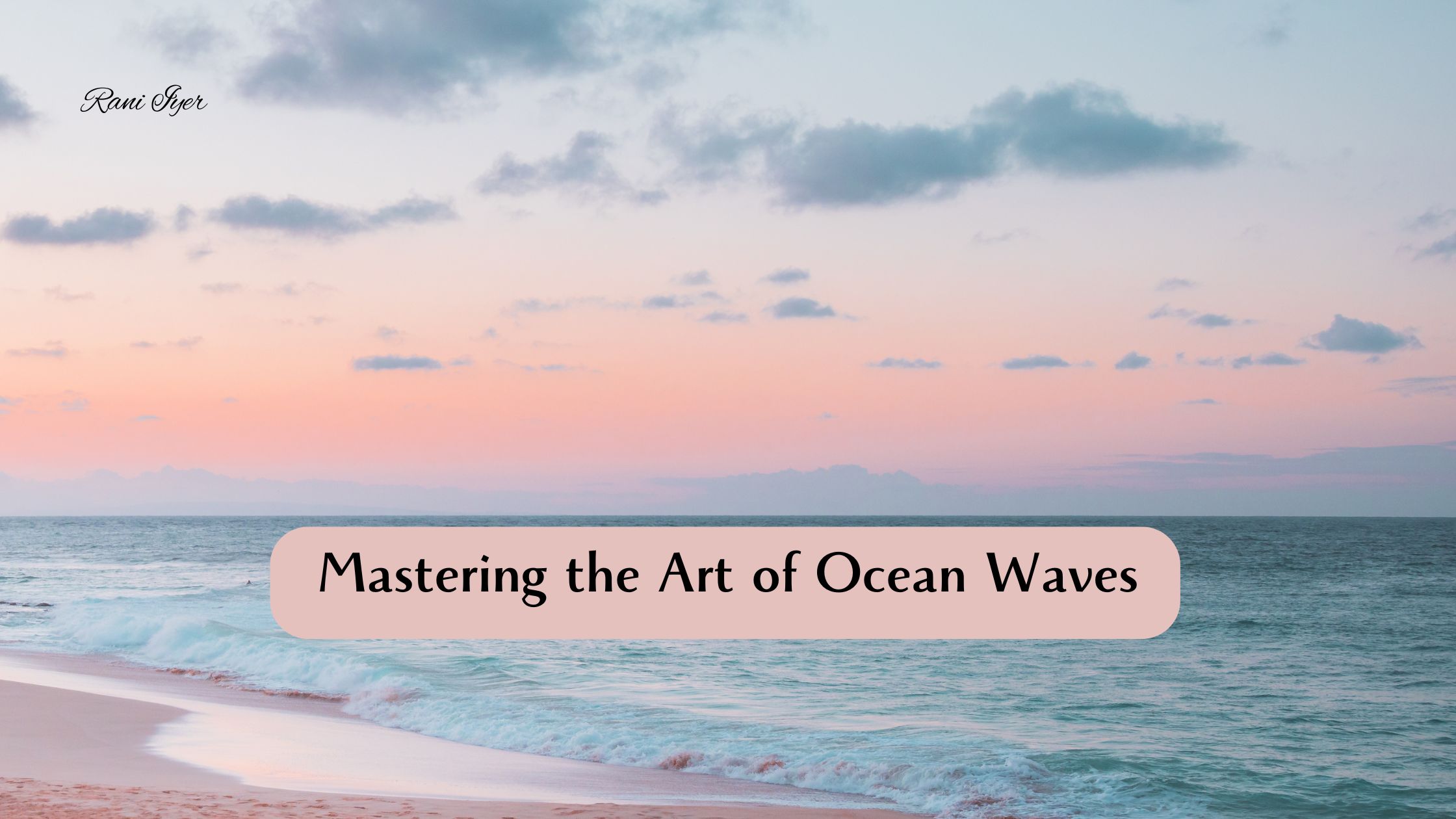The mesmerizing beauty of ocean waves has inspired artists for centuries, capturing the awe of nature’s dynamic rhythms. For those keen on transforming their passion for the sea into stunning seascape paintings, mastering this art form can bring an unparalleled sense of fulfillment. This step-by-step guide invites you to dive deep into the techniques and secrets that will elevate your artistic journey. From understanding light and color dynamics to mastering brush strokes that mimic the ebb and flow of water, we’ll explore essential skills and creative tips to bring your canvas to life. Whether you’re an aspiring painter or simply looking to refine your abilities, this guide will help you navigate the waves of creativity, allowing you to capture the essence of the ocean in your own unique style. Prepare to unleash your inner artist and reflect the beauty of the sea in breathtaking masterpieces!
Understanding Ocean Waves: Anatomy and Movement
To master the art of capturing ocean waves on canvas, one must first understand their anatomy and movement. Ocean waves are a complex interplay of energy and water, with each wave possessing distinct characteristics, such as height, frequency, and shape. The anatomy of a wave includes the crest (the highest point), the trough (the lowest point), and the wave height (the vertical distance between the crest and trough). Observing real-life waves or studying photographs can help artists become familiar with these details, ensuring that their paintings resonate with authenticity.
Waves are primarily generated by wind, with their size and shape influenced by factors such as wind speed, duration, and fetch (the distance over which the wind blows). Understanding these factors can help artists depict different types of waves, from gentle ripples to powerful breakers. Additionally, waves interact with the shore in various ways, creating unique patterns and effects. For instance, plunging waves crash forcefully onto the shore, while spilling waves gently roll in. By grasping these nuances, painters can accurately represent the dynamic nature of the ocean.
Movement is an essential aspect of ocean waves, and capturing it on canvas can bring a painting to life. Waves possess a rhythm and flow that can be challenging to depict, but with practice and observation, artists can learn to convey this movement through their brushwork. Pay attention to the direction and speed of the waves, as well as how they interact with each other and the shore. By doing so, you can create paintings that not only look realistic but also evoke the sense of motion and energy inherent in the ocean.
Essential Materials for Seascape Painting
Creating stunning seascape paintings requires the right materials, which can significantly impact the quality and outcome of your work. Selecting high-quality supplies ensures that your artwork will stand the test of time and allows you to focus on the creative process without being hindered by technical issues. Some essential materials for seascape painting include canvases, brushes, paints, and mediums.
The canvas is the foundation of your painting, and choosing the right one is crucial. Canvases come in various sizes, textures, and materials, such as cotton and linen. For seascapes, a medium to large-sized canvas with a fine to medium texture is ideal, as it allows for detailed work while providing enough space to capture the vastness of the ocean. Additionally, consider using pre-primed canvases or applying gesso yourself to ensure a smooth surface for painting.
Brushes are another vital component of your seascape painting toolkit. A variety of brush types and sizes will enable you to achieve different effects and textures. Flat brushes are excellent for creating broad strokes and covering large areas, while round brushes are perfect for detailed work and fine lines. Additionally, fan brushes can be used to create the illusion of spray and foam, adding realism to your waves. Investing in high-quality brushes made from natural or synthetic fibers will provide better control and durability.
Paints and mediums play a significant role in the final appearance of your seascape. Oil paints are a popular choice for their rich colors and blending capabilities, but acrylics and watercolors can also produce stunning results. When selecting paints, opt for professional-grade options, as they offer better pigmentation and longevity. Mediums, such as linseed oil or acrylic gel, can be used to modify the consistency and drying time of your paints, allowing you to achieve different effects and work at your own pace.
Color Theory: Capturing the Essence of the Ocean
Color theory is a fundamental aspect of painting, and understanding it can significantly enhance your ability to capture the essence of the ocean. The colors used in seascape paintings are crucial in conveying the mood, atmosphere, and movement of the waves. Knowing how to mix and apply colors effectively will enable you to create more realistic and evocative seascapes.
The ocean’s color palette is diverse, ranging from deep blues and greens to warm hues of sunlight reflecting off the water. A basic understanding of color theory, including the color wheel, complementary colors, and color temperature, can help you make informed choices when mixing and applying colors. For instance, using complementary colors, such as blue and orange, can create striking contrasts and add vibrancy to your painting. Additionally, understanding color temperature (warm vs. cool colors) can help you convey depth and atmosphere.
When painting the ocean, it’s essential to consider the effects of light on water. The color of the ocean can change dramatically depending on the time of day, weather conditions, and the angle of the light. For example, during sunrise or sunset, the ocean may take on warm, golden tones, while on a cloudy day, it may appear more muted and gray. Observing these changes and learning to replicate them on canvas will add realism and depth to your seascapes.
Creating a sense of depth in your painting involves using a range of values (light and dark) and hues (color variations). Darker values can be used to depict the deeper parts of the ocean, while lighter values can represent the crest of the waves and areas where light is reflecting off the water. Additionally, incorporating subtle color shifts within the waves can add complexity and interest to your painting. By mastering these techniques, you’ll be able to capture the ever-changing beauty of the ocean in your artwork.
Techniques for Painting Realistic Waves
Painting realistic waves requires a combination of observation, practice, and mastery of various techniques. One of the most effective ways to achieve realism is by breaking down the waves into their basic shapes and forms. Start by sketching the overall structure of the waves, including the crest, trough, and foam. This initial sketch will serve as a foundation for your painting, allowing you to build up layers of color and detail gradually.
Layering is a crucial technique in seascape painting, as it helps create depth and dimension. Begin by applying a base layer of color to represent the overall tone of the ocean. Once the base layer is dry, add successive layers of color and detail, gradually building up the complexity of the waves. Use a combination of glazing (applying thin, transparent layers of paint) and scumbling (applying a thin, opaque layer of paint) to create the illusion of depth and movement.
Another essential technique for painting realistic waves is mastering brushwork. Different brushstrokes can be used to mimic the texture and movement of water. For instance, using a dry brush technique (applying paint with a brush that has very little paint on it) can create a rough, textured effect, ideal for depicting foam and spray. Additionally, varying the direction and pressure of your brushstrokes can help convey the dynamic motion of the waves. Experiment with different brushes and techniques to find the ones that work best for you.
Step-by-Step Process for Creating a Seascape
Creating a seascape painting involves a step-by-step process that ensures each element of the scene is accurately represented. Begin by selecting a reference image or observing the ocean in real life. This will serve as your guide throughout the painting process. Start by sketching the basic composition on your canvas, including the horizon line, waves, and any other elements you plan to include, such as rocks or boats.
Once your sketch is complete, apply a base layer of color to establish the overall tone and mood of the painting. For the sky, use a gradient of light to dark colors, starting with the lightest color at the horizon and gradually transitioning to darker shades as you move upwards. For the ocean, use a range of blues and greens, with darker shades in the deeper areas and lighter shades near the shore. Allow this base layer to dry before moving on to the next step.
Next, begin adding layers of detail to the waves. Start with the larger waves, using a combination of glazing and scumbling techniques to create depth and dimension. Pay attention to the direction and shape of the waves, ensuring they follow the natural flow of the ocean. Once the larger waves are complete, add smaller waves and foam, using a dry brush technique to create texture. Finally, add any additional elements, such as reflections, shadows, and highlights, to bring the painting to life.
Tips for Adding Depth and Dimension to Your Painting
Adding depth and dimension to your seascape painting can make it more realistic and engaging. One effective way to achieve this is by using a range of values (light and dark) to create contrast. Darker values can be used to depict the deeper parts of the ocean, while lighter values can represent areas where light is reflecting off the water. By incorporating a range of values, you can create the illusion of depth and make your painting more visually interesting.
Another technique for adding depth is by using perspective. Atmospheric perspective, which involves using lighter, cooler colors for distant objects and darker, warmer colors for closer objects, can help create the illusion of depth in your painting. Additionally, using linear perspective, which involves depicting objects that are closer to the viewer as larger and those that are farther away as smaller, can further enhance the sense of depth.
Texture is another important element in creating depth and dimension. Different brushstrokes and techniques can be used to mimic the texture of water, foam, and other elements in your painting. For example, using a dry brush technique can create a rough, textured effect, ideal for depicting foam and spray. Experimenting with different textures and techniques can add complexity and interest to your seascape, making it more lifelike and engaging.
Common Mistakes to Avoid in Seascape Painting
Seascape painting can be challenging, and there are several common mistakes that artists should avoid to achieve the best results. One common mistake is overworking the painting. It’s essential to know when to stop and allow the painting to rest. Overworking can lead to muddy colors and a loss of vibrancy. Instead, take breaks and step back to assess your work from a distance. This will help you maintain a fresh perspective and avoid overworking.
Another common mistake is neglecting the importance of light and shadow. Light and shadow play a crucial role in creating depth and realism in a painting. Pay attention to the direction and intensity of light in your reference image or scene, and replicate it accurately in your painting. This will help create a sense of three-dimensionality and make your seascape more lifelike.
Finally, avoid using too many colors or creating unrealistic color combinations. While it’s essential to capture the diverse colors of the ocean, using too many colors can make your painting appear chaotic and unbalanced. Instead, focus on a cohesive color palette that reflects the natural tones of the ocean. Additionally, avoid using colors that clash or do not harmonize with each other. By carefully selecting and mixing your colors, you can create a more harmonious and visually appealing seascape.
Inspiring Seascape Artists and Their Work
Throughout history, many artists have been inspired by the beauty and power of the ocean, creating stunning seascape paintings that continue to captivate audiences. One such artist is J.M.W. Turner, a British painter known for his dramatic and atmospheric seascapes. Turner’s ability to capture the dynamic movement of the ocean and the interplay of light and color in his paintings has made him one of the most celebrated seascape artists of all time.
Another inspiring seascape artist is Winslow Homer, an American painter renowned for his realistic and emotive depictions of the sea. Homer’s seascapes often feature powerful waves crashing against rugged coastlines, conveying the raw energy and majesty of the ocean. His use of light and shadow, as well as his attention to detail, has made his work a source of inspiration for many contemporary artists.
Contemporary artist Alyssa Monks is also known for her captivating seascapes. Monks’ paintings often depict the ocean in a more abstract and emotive manner, using bold brushstrokes and vibrant colors to convey the movement and energy of the waves. Her unique approach to seascape painting has garnered widespread acclaim and has inspired many artists to explore new techniques and styles.
Embracing Your Artistic Journey
Mastering the art of ocean waves and creating stunning seascape paintings is a rewarding and fulfilling endeavor. By understanding the anatomy and movement of waves, selecting the right materials, and applying essential techniques, you can elevate your artistic skills and create captivating seascapes that capture the beauty and power of the ocean. Remember that practice and observation are key to improving your craft, so take the time to study real-life waves and experiment with different techniques.
As you continue your artistic journey, don’t be afraid to make mistakes and learn from them. Each painting is an opportunity to grow and develop your skills, and every brushstroke brings you closer to mastering the art of seascape painting. Embrace the creative process and enjoy the sense of fulfillment that comes from transforming your passion for the ocean into breathtaking masterpieces.
Finally, draw inspiration from the work of other seascape artists and find your unique style. By studying their techniques and approaches, you can gain valuable insights and discover new ways to express your creativity. With dedication, practice, and a love for the ocean, you can master the art of seascape painting and create stunning works of art that resonate with viewers and capture the essence of the sea.


